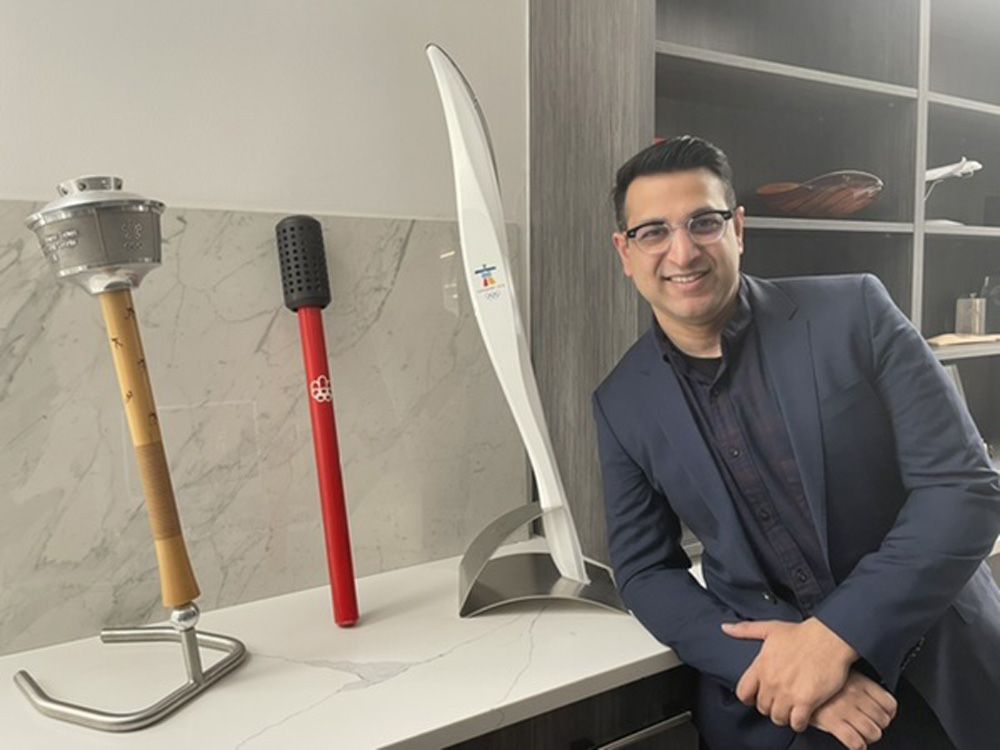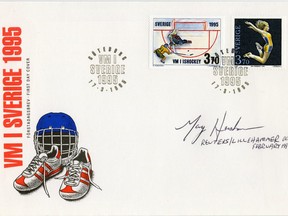‘It is all about the torches’: Olympic memorabilia commands big bucks among collectors

Olympic torches can sell for over US$300,000

Article content
Somewhere, and exactly where Corey Hirsch cannot say, is a series of postcards the retired NHL goaltender penned to friends and family members from Gavle, Sweden, in the spring of 1995.
Advertisement
Story continues below
This advertisement has not loaded yet, but your article continues below.
Article content
Affixed to each postcard was a celebrated, engraved, limited-edition Swedish postage stamp, released to coincide with the start of that year’s Ice Hockey World Championship tournament. Hirsch, now a Vancouver Canucks broadcaster, was playing for Canada at the time. The stamp, though, depicted an event hockey aficionados, particularly those with Swedish ties, referred to then and now as: The Forsberg Goal.
It was scored the previous winter at the 1994 Winter Olympics in Lillehammer, Norway, by Sweden’s Peter Forsberg, who deked a sprawling Hirsch out of his metaphorical jockstrap in a shootout win over Canada, giving the Swedes the gold. It also gave the goalie something to write home about a year later, since the Swedish postal service produced a stamp depicting the famous deke in the aftermath of the Olympic victory.
Advertisement
Story continues below
This advertisement has not loaded yet, but your article continues below.
Article content
“I have some of the stamps somewhere in storage,” said Hirsch, who initially protested against the stamp, but ultimately warmed to the philatelic tribute. “And I mailed a bunch of postcards home to my buddies and my Mom and Dad, but who knows where those are now.”
Olympic-loving philatelists approach Hirsch “all the time,” he said, asking him to autograph envelopes with the Swedish stamp attached. He always obliges, understanding that in the market of Olympic memorabilia stamps, even signed ones, aren’t particularly valuable. (A second-hand Hirsch can be yours for less than $50 on eBay.)

But the stamps are just one corner of a much broader Olympic collectibles market. Souvenir hunters shell out truly big money for gold medals, as one might have guessed — a Jesse Owens’ 1936 gold medal reportedly sold for US$1.47 million a decade ago — and torches, as one most likely would not.
Advertisement
Story continues below
This advertisement has not loaded yet, but your article continues below.
Article content
“Torches can sell for over US$300,000,” said Ingrid O’Neil, universally recognized among collectors as the one-woman dean of Olympic auctions, having held three per year, each year, since 1990.
Ingrid O’Neil Auctions, Sports and Olympic Memorabilia has buyers worldwide, and she has worked with the United States Olympic Committee, as well as the Brazilian Olympic Committee, an experience that led to a kerfuffle with Brazilian customs over inbound Olympic artifacts that convinced her to stop holding live auctions.
“I don’t even want to get into what happened in Rio,” she said.
Torches can sell for over US$300,000
Ingrid O’Neil
Explaining the appeal of torch collecting is a much less fraught subject for the California-based grandmother. Unbeknownst to many, more than one torch is produced for an Olympic torch relay. In other words, the torch you see lighting the Olympic cauldron to open a Games isn’t the same torch that gets lit months earlier and departs from Olympia, Greece.
Advertisement
Story continues below
This advertisement has not loaded yet, but your article continues below.
Article content
Serious collectors covet torches generally, but particularly those in lesser supply, such as the 23 made for the Squaw Valley 1960 Winter Olympics.
Canadians, O’Neil notes, are typically more interested in collecting hockey memorabilia, and so the market for torches, medals and such tends to be pretty thin here, beyond a select group of top-end buyers, among whom is Usman Tahir Jutt, a Calgary restaurateur and philanthropist.
“It is all about the torches for me,” the 37-year-old said. “Everybody knows the Olympic flame. It is steeped in tradition, and you get these design briefs of torches that, in my opinion, represent the best in art, design — these things are marvels — because they have to look cool, and they have to weigh nothing, because people have to run with them.”
Advertisement
Story continues below
This advertisement has not loaded yet, but your article continues below.
Article content
Everybody knows the Olympic flame. It is steeped in tradition
Usman Tahir Jutt
Jutt was an art collector when his interest in torches initially flared seven years ago. Many thousands of dollars later, he has amassed a significant torch collection. He won’t say just how many torches he owns, but his collection started with a Calgary 1988 Olympic torch, about 100 of which were produced, that he bought off Kijiji.
“It is heavier than most torches, so you can’t really run long distances with it, and it is clunky looking — it literally looks like the Calgary Tower — but I am from Calgary, and so …”
And so he bought the torch. Today, it sits in a stand behind his desk at his Calgary office. Kids have been known to play with it, and adults often ask about its origins, creating an opening for a torch story Jutt doesn’t tire of telling.
Advertisement
Story continues below
This advertisement has not loaded yet, but your article continues below.
Article content
Displayed alongside the Calgary torch is a Montreal 1976 torch, which are more numerous and were designed to project a futuristic vibe, as well as a Vancouver 2010 torch, a streamlined number created by Bombardier Inc., to round out his Canadian Olympic set.
“I am looking to collect all the torches,” Jutt said. “But that’s a lifetime endeavour. Really, it is an impossible task.”
I am looking to collect all the torches
Usman Tahir Jutt
Well, perhaps not entirely impossible, depending on how much money someone is willing to throw around, and how much time someone has to invest in the hunt. With two young children at home, Jutt currently doesn’t have time, but maybe, someday.
It pays to be ready, because it is impossible to predict when a torch will come up for sale, particularly the rarer ones, O’Neil said. She has some doozy stories, including one about a European matriarch, and the strange-looking candle holder on the dining room table that her children didn’t pay much attention to.
Advertisement
Story continues below
This advertisement has not loaded yet, but your article continues below.
Article content
“Her children only found out later that the candle holder was actually a Stockholm torch,” O’Neil said.
It was a lucrative discovery: Only a handful of Stockholm torches are known to exist, and two of them are already housed in a Swedish museum. The candle holder/torch sold at auction for just shy of US$500,000, or about 10,000 times more than a “pre-owned” Corey Hirsch postage stamp goes for these days.
But Hirsch Olympic memorabilia has a value far greater than the cost of an actual stamp. Nostalgia, history, participating in a fleeting Olympic moment that doesn’t seem to age, even as old hockey players do, is priceless. Imagine: No Forsberg, no Hirsch, no Lillehammer, no postcards for a retired goalie to reflect upon 28 years later.
Advertisement
Story continues below
This advertisement has not loaded yet, but your article continues below.
Article content
-

Mark McMorris Inc: Inside an Olympic snowboarder’s business empire
-

Red Mitten Confidential: The untold story of a Canadian Olympic fashion icon
-

Why SkipTheDishes co-founder Jeff Adamson is stacking his newest startup with ex-Olympians
The pads Hirsch wore when Forsberg executed the deke are in the Hockey Hall of Fame in Toronto. His daughter keeps his silver medal, which he brings to events when he speaks about mental health and living, as he does, with obsessive compulsive disorder.
Hirsch also held onto his gloves and mask. Had he been aware, he might have considered acquiring a LIllehammer torch, too, since buying one today costs about $60,000.
“I should have collected more at the Olympics, but I was just a kid back then,” he said. ”You don’t think about how significant those Olympic moments can still be for people, even years later.”
Most people don’t think about collecting stamps or torches, or a grandmother in California who holds thrice annual, globally renowned, mail-in only — thanks to Rio — Olympic auctions.
“You could specialize in Canada,” O’Neil said, offering a helpful collecting tip. “There are so many possibilities with the Olympics; it all depends on what you want and how much money you are willing to spend.”
• Email: [email protected] | Twitter: oconnorwrites
Advertisement
Story continues below
This advertisement has not loaded yet, but your article continues below.








